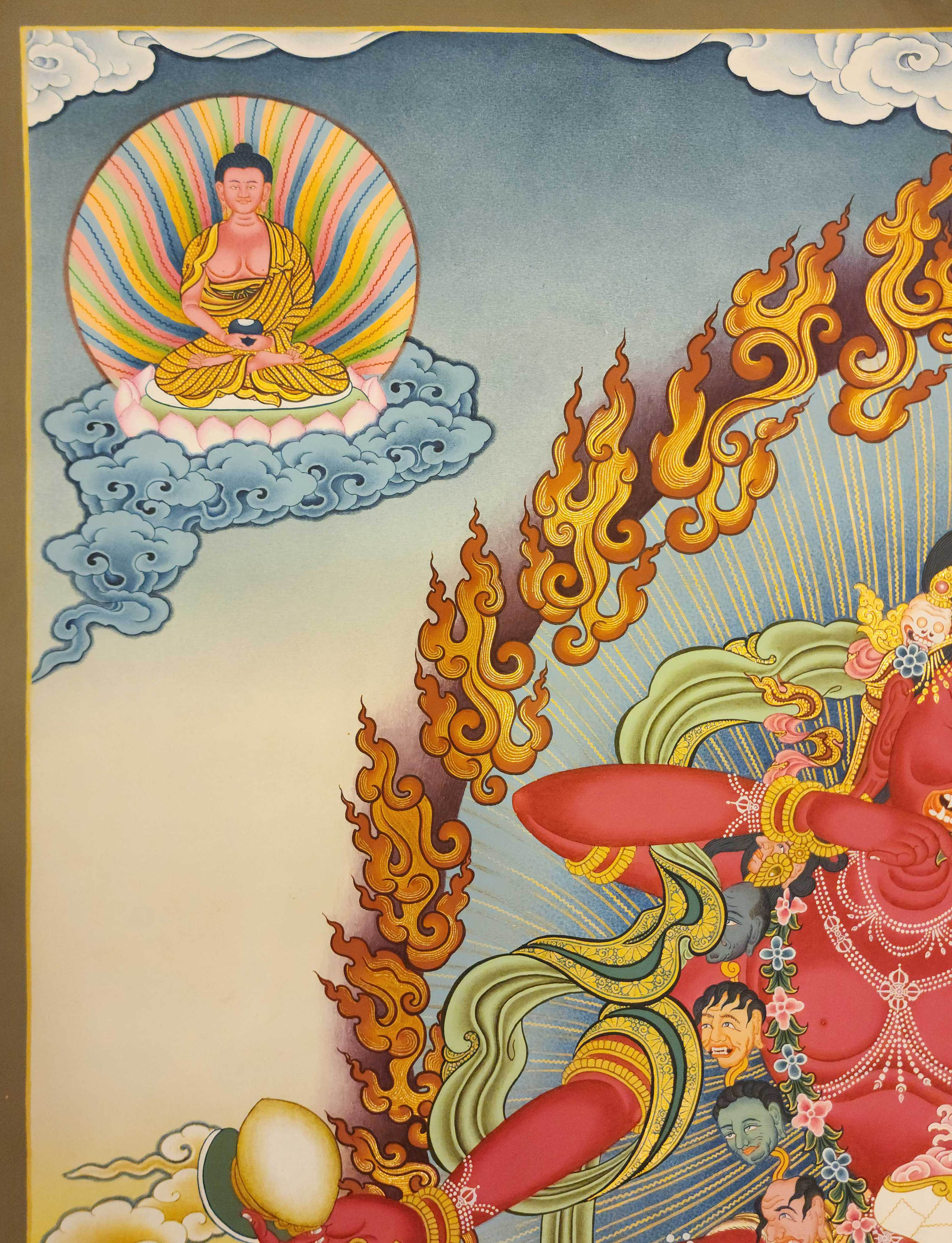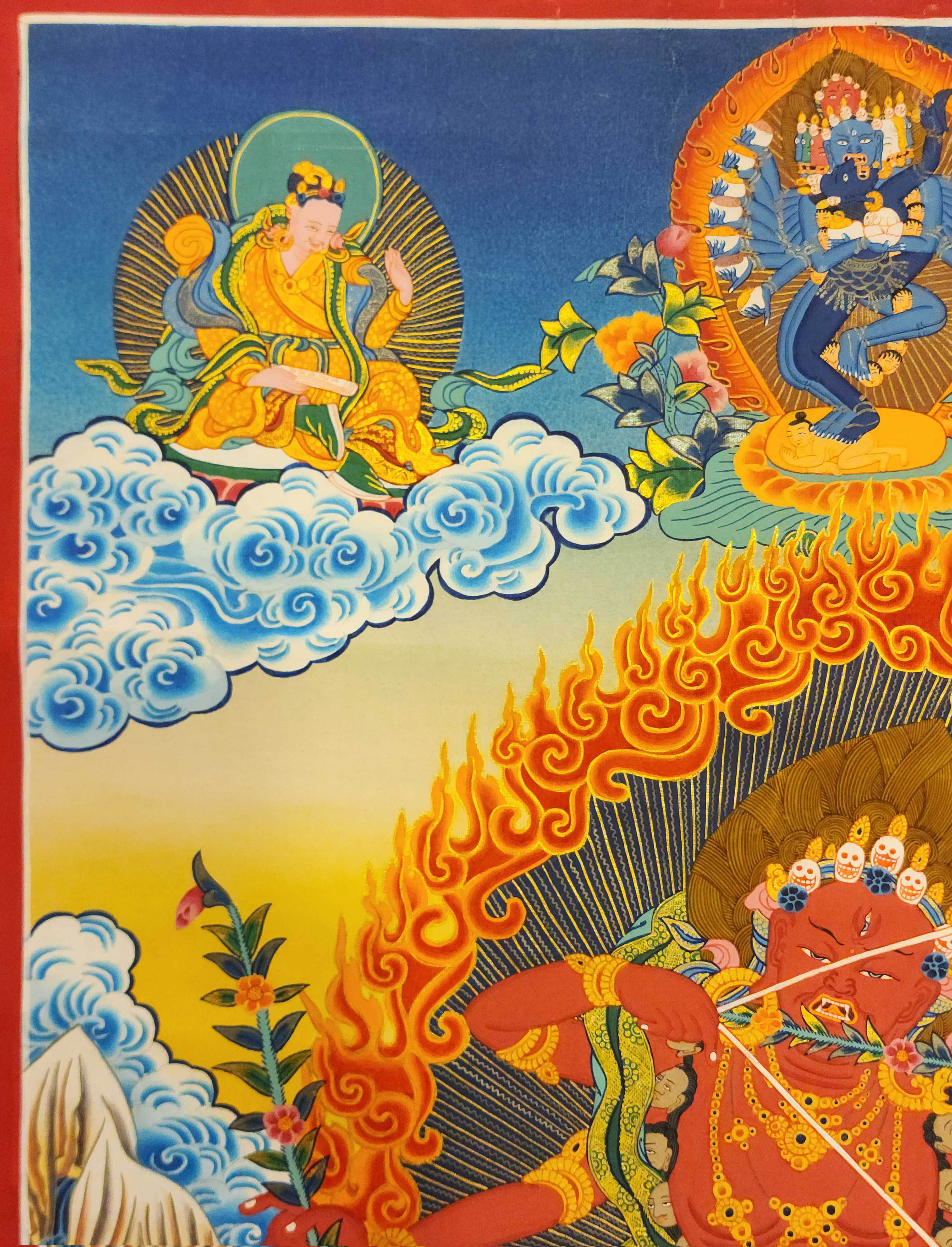Code
HCS18608
Weight
100 gm / 0.22 lbs
Size
Height
50cm (20") Width
38cm (15") Material
Handmade Canvas
Availability
Subject to Avilability
Date Added
2020-06-26 00:29:08
Note : We used to sell this product 5 years ago so it may no longer be in our stock.
It is possible that we still have it with our suppliers but the price could be different from before.
Feel free to order. We will verify availability and inform you promptly.
It is possible that we still have it with our suppliers but the price could be different from before.
Feel free to order. We will verify availability and inform you promptly.

Safe Payment
We accept Paypal, Money Transfer, Bank Transfer
Confidence
Protection covers your purchase and personal data.
Worldwide Delivery
We ship Worldwide, except Russia.Shipping cost US$25.2 for upto 0.5 kgs

Hotline
Talk to help line for your question on 9841267335Remakable : Remakable
Please note that the Tibetan Thangka Of Kurukulla Yogini With [real Gold], [red Tara], Rigjeyma, Pema Khandro, Wangyi Lhamo, Red Tara, [remakable] we posted some time ago is not currently available in our store. However, due to the possibility of a remake, it is still on sale. The remake will not be an exact replica of the original statue shown in the picture and will require additional time to be ready for dispatch. If you are willing to wait for this custom remake, you may proceed with your order. Thank you for your understanding and patience.
Please note that the Tibetan Thangka Of Kurukulla Yogini With [real Gold], [red Tara], Rigjeyma, Pema Khandro, Wangyi Lhamo, Red Tara, [remakable] we posted some time ago is not currently available in our store. However, due to the possibility of a remake, it is still on sale. The remake will not be an exact replica of the original statue shown in the picture and will require additional time to be ready for dispatch. If you are willing to wait for this custom remake, you may proceed with your order. Thank you for your understanding and patience.
Use of Real Gold
This thangka of Tibetan Thangka Of Kurukulla Yogini With [real Gold], [red Tara], Rigjeyma, Pema Khandro, Wangyi Lhamo, Red Tara, [remakable] has real gold painted on its surface along with other paints. This is an ancient process of decorating the thangka in Tibetan Buddhism, Here gold is ground into gold dust, which is then mixed with other undisclosed material to make it paintable on the canvas. this mixture is then mixed with transparent glue and painted on the thangka. Read More . . .
This thangka of Tibetan Thangka Of Kurukulla Yogini With [real Gold], [red Tara], Rigjeyma, Pema Khandro, Wangyi Lhamo, Red Tara, [remakable] has real gold painted on its surface along with other paints. This is an ancient process of decorating the thangka in Tibetan Buddhism, Here gold is ground into gold dust, which is then mixed with other undisclosed material to make it paintable on the canvas. this mixture is then mixed with transparent glue and painted on the thangka. Read More . . .
Introduction to Thangka
A thangka, also known as tangka, thanka, or tanka, is a vibrant and intricate Tibetan Buddhist painting that serves as a visual representation of spiritual teachings. Crafted with meticulous detail on cotton or silk appliqué, thangkas depict a wide range of subjects including Buddhist deities, sacred scenes, mandalas, and narrative stories. These sacred artworks are traditionally kept unframed and rolled up for storage, resembling ancient scrolls. To protect their delicate nature, thangkas are mounted on textile backings and often adorned with a silk cover on the front. Proper preservation in dry environments is crucial to maintain the integrity and longevity of the silk. Read More . . .
A thangka, also known as tangka, thanka, or tanka, is a vibrant and intricate Tibetan Buddhist painting that serves as a visual representation of spiritual teachings. Crafted with meticulous detail on cotton or silk appliqué, thangkas depict a wide range of subjects including Buddhist deities, sacred scenes, mandalas, and narrative stories. These sacred artworks are traditionally kept unframed and rolled up for storage, resembling ancient scrolls. To protect their delicate nature, thangkas are mounted on textile backings and often adorned with a silk cover on the front. Proper preservation in dry environments is crucial to maintain the integrity and longevity of the silk. Read More . . .
Brief Introduction :
The essential mantra of Kurukull? is O? Kurukulle Hr?? Sv?h? (Tibetan: ??????????????????????????).

Kurukulla, also known as Rigiyedma or Red Tara, is a revered yogini deity in Tibetan Buddhism, embodying enchantment, magnetism, and love. With her captivating form and vibrant red color, she represents the transformative power of attraction. Kurukulla's multiple arms hold symbolic objects, including a bow and arrow, a noose, a flower, and a hook, symbolizing her ability to strike desires, bind aspirations, spread love, and captivate aspirations. Although specific temples dedicated to Kurukulla may be scarce in Nepal, her presence can be found in Tibetan Buddhist monasteries worldwide. Devotees practice Kurukulla to manifest their desires, transform challenges, and radiate love and positivity in their lives.
Iconography:
Kurukulla is typically depicted as a youthful and beautiful goddess, often depicted in a dancing posture. She is adorned with a crown, multiple arms, and holds various symbolic objects such as a bow and arrow, noose, flower, and a hook. Her vivid red color symbolizes her passionate and transformative qualities.
History:
Kurukulla has her roots in ancient Indian traditions, particularly within the Shakta and Tantra traditions. Over time, her worship was incorporated into Tibetan Buddhism, where she became recognized as a powerful deity associated with magnetism, attraction, and love.
Temples and Monasteries:
There might not be specific temples dedicated solely to Kurukulla in Nepal. However, you can find representations or depictions of Kurukulla in various Tibetan Buddhist monasteries and temples worldwide. Monastic institutions such as Swayambhunath Stupa in Kathmandu, Nepal, may feature images of Kurukulla.
Benefits of Practicing Kurukulla:
Devotees believe that practicing Kurukulla can help enhance one's magnetism, charm, and ability to attract positive influences and circumstances. She is associated with love, passion, and the power to transform difficult situations into favorable ones.
How to Practice:
To practice Kurukulla, one can engage in meditation and visualization practices focused on the deity. Meditating on Kurukulla's image, imagining her qualities manifesting within oneself, and reciting mantras can form a part of the practice. Additionally, practitioners may also engage in rituals and offerings to invoke her blessings.
Mantras of Kurukulla:
A common mantra associated with Kurukulla is: "Om Kurukulle Hrih Svaha." This mantra can be recited during meditation or as part of devotional practices to invoke the energies and blessings of Kurukulla.
Kurukulla is typically depicted as a youthful and beautiful goddess, often depicted in a dancing posture. She is adorned with a crown, multiple arms, and holds various symbolic objects such as a bow and arrow, noose, flower, and a hook. Her vivid red color symbolizes her passionate and transformative qualities.
History:
Kurukulla has her roots in ancient Indian traditions, particularly within the Shakta and Tantra traditions. Over time, her worship was incorporated into Tibetan Buddhism, where she became recognized as a powerful deity associated with magnetism, attraction, and love.
Temples and Monasteries:
There might not be specific temples dedicated solely to Kurukulla in Nepal. However, you can find representations or depictions of Kurukulla in various Tibetan Buddhist monasteries and temples worldwide. Monastic institutions such as Swayambhunath Stupa in Kathmandu, Nepal, may feature images of Kurukulla.
Benefits of Practicing Kurukulla:
Devotees believe that practicing Kurukulla can help enhance one's magnetism, charm, and ability to attract positive influences and circumstances. She is associated with love, passion, and the power to transform difficult situations into favorable ones.
How to Practice:
To practice Kurukulla, one can engage in meditation and visualization practices focused on the deity. Meditating on Kurukulla's image, imagining her qualities manifesting within oneself, and reciting mantras can form a part of the practice. Additionally, practitioners may also engage in rituals and offerings to invoke her blessings.
Mantras of Kurukulla:
A common mantra associated with Kurukulla is: "Om Kurukulle Hrih Svaha." This mantra can be recited during meditation or as part of devotional practices to invoke the energies and blessings of Kurukulla.
| Kurukull? at Samye | Kurukulla sculpture from Calcutta Art gallery, 1913 |
The mantra of Kurukulla
The essential mantra of Kurukull? is O? Kurukulle Hr?? Sv?h? (Tibetan: ??????????????????????????).


![Tibetan Thangka Of Kurukulla Yogini With [real Gold], [red Tara], Rigjeyma, Pema Khandro, Wangyi Lhamo, Red Tara, [remakable]](https://handicraftseller.com/uploads/pics/product/thumb/2020/06/18608_0.jpg)
![Tibetan Thangka Of Kurukulla Yogini With [real Gold], [red Tara], Rigjeyma, Pema Khandro, Wangyi Lhamo, Red Tara, [remakable]](https://handicraftseller.com/uploads/pics/product/thumb/2020/06/18608_1.jpg)
![Tibetan Thangka Of Kurukulla Yogini With [real Gold], [red Tara], Rigjeyma, Pema Khandro, Wangyi Lhamo, Red Tara, [remakable]](https://handicraftseller.com/uploads/pics/product/thumb/2020/06/18608_2.jpg)
![Tibetan Thangka Of Kurukulla Yogini With [real Gold], [red Tara], Rigjeyma, Pema Khandro, Wangyi Lhamo, Red Tara, [remakable]](https://handicraftseller.com/uploads/pics/product/thumb/2020/06/18608_3.jpg)
![Tibetan Thangka Of Kurukulla Yogini With [real Gold], [red Tara], Rigjeyma, Pema Khandro, Wangyi Lhamo, Red Tara, [remakable]](https://handicraftseller.com/uploads/pics/product/thumb/2020/06/18608_4.jpg)
![Tibetan Thangka Of Kurukulla Yogini With [real Gold], [red Tara], Rigjeyma, Pema Khandro, Wangyi Lhamo, Red Tara, [remakable]](https://handicraftseller.com/uploads/pics/product/thumb/2020/06/18608.jpg)










 Master Quality Buddhist Handmade Thangka Painting,
Master Quality Buddhist Handmade Thangka Painting,  Master Quality Buddhist Handmade Thangka Painting,
Master Quality Buddhist Handmade Thangka Painting,  Real Gold, Rigjeyma, Pema Khandro, Wangyi Lhamo, Red Tara" title="Kurukulla, Buddhist Handmade Thangka Painting,
Real Gold, Rigjeyma, Pema Khandro, Wangyi Lhamo, Red Tara" title="Kurukulla, Buddhist Handmade Thangka Painting,  Real Gold, Rigjeyma, Pema Khandro, Wangyi Lhamo, Red Tara" title="Kurukulla, Buddhist Handmade Thangka Painting,
Real Gold, Rigjeyma, Pema Khandro, Wangyi Lhamo, Red Tara" title="Kurukulla, Buddhist Handmade Thangka Painting,